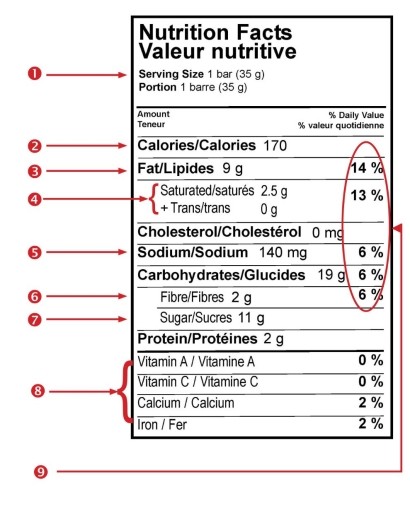1. What is the serving size?
Often, the serving size for a food is different for different brands. For example, one serving of Froot Loops cereal is 3/4 cup (27 grams) while one serving of Quaker Harvest Crunch cereal is 2/3 cup (45 g). When comparing foods with serving sizes that are significantly different, you will have to do a bit of calculating to ensure that you are comparing the same amount of food. In the nut bar example the serving size is one bar that weighs 35 grams.
2. How many calories are in a serving?
There can be a big difference between brands. Be aware that a food may seem to be low-calorie but the serving size on the “Nutrition Facts” panel may be very small. The nut bar has 170 calories.
3. What percentage of calories comes from fat?
The amount of fat on a Nutrition Facts panel is listed in grams. This can be useful to identify foods that are low in fat. However, you also need to consider what percentage of the total calories comes from fat. To do this, multiply the grams of fat by nine (there are nine calories per gram of fat), divide that number by the total calories and then multiply by 100.
For the nut bar example, the percent of calories from fat = [(9 x 9) / 70] x 100 = 48%. Almost half of the nut bar’s calories come from fat. (Note: The % Daily Value is not the same as the % of calories from fat in the product.)
4. Do saturated and trans fat account for a high proportion of total fat?
Because of an association with health problems, it is recommended to avoid trans fat and to keep saturated fats to less than 10% of daily calories. The nutrition label for the nut bar indicates that it contains no trans fat, while saturated fat accounts for just under one-third of the total fat in this product (2.5 grams of saturated fat in 9 grams of total fat).
5. Is the food low in sodium?
You should aim to consume less than 2,300 mg of sodium each day, which is the amount of sodium in one teaspoon of table salt. The nut bar is relatively low in sodium (140 mgs).
6. How much fibre is in the product?
Aim for 25 to 35 grams of fibre each day from foods, not supplements. This bar contains some fibre (2 grams). High fibre foods contain 4 to 6 grams of fibre per serving.
7. How much sugar is in the product?
The amount of sugar listed on the Nutrition Facts panel includes both the sugar that occurs naturally in the ingredients and added sugars (e.g., white sugar). One teaspoon of sugar weighs four grams. Therefore, the nut bar has just less than three teaspoons of sugar (11 grams). Note, though, that almost one-third of the weight of the bar is sugar (11 of the 35 grams)!
8. Is the food rich in vitamins and minerals?
The Nutrition Facts panel indicates "% Daily Value" numbers for two vitamins (A and C) and two minerals (calcium and iron) only. You can tell if a food is rich in these particular nutrients if their “% Daily Value” is high.
9. Don’t pay too much attention to the “% Daily Values” for nutrients
These values are based on a 2,000 calorie/day diet, which is the amount of calories needed by a moderately active person of 68 kg (150 pounds). Larger people and those who are more active require more calories. If you need more or less than 2,000 calories a day, this information will not be appropriate for you. However, it can give you an idea of which nutrients are abundant (large % daily value number) and which are not (low number).

